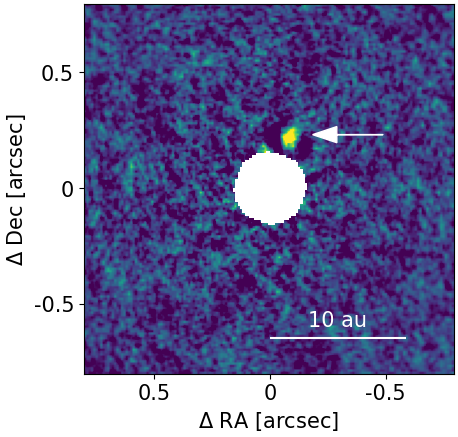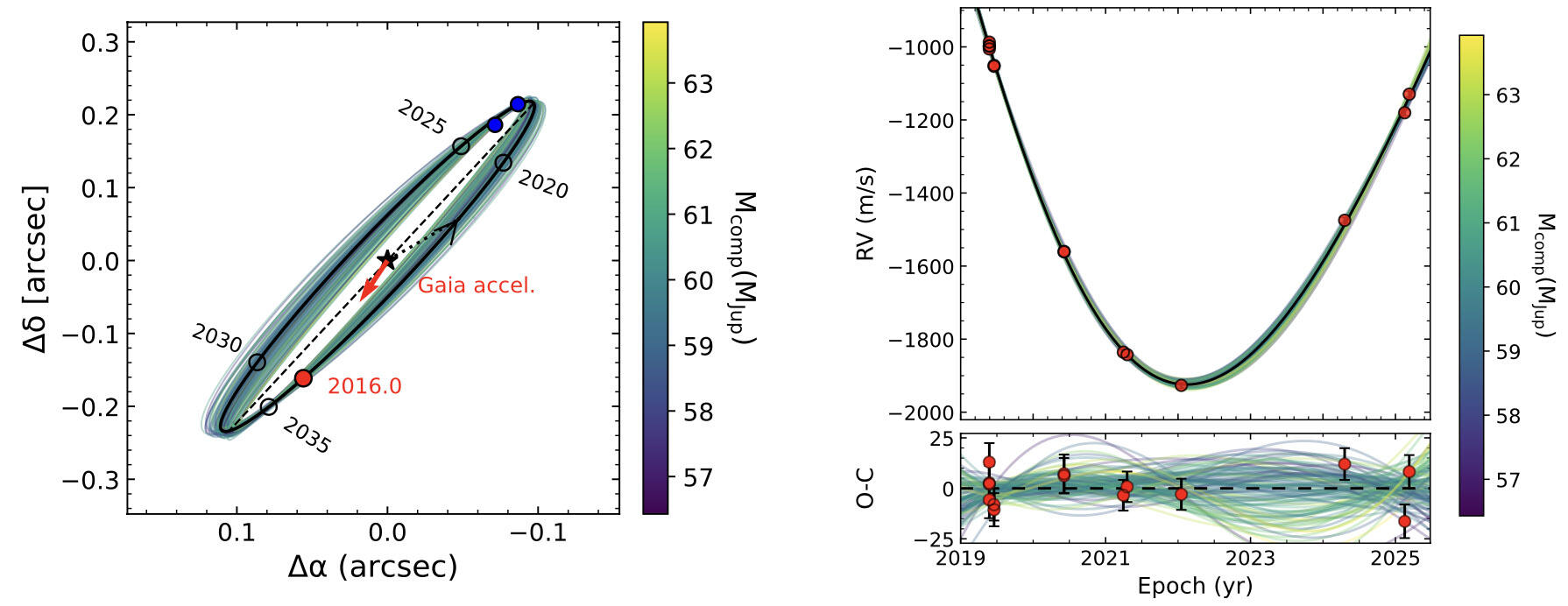By combining the power of ground-based and space-based telescopes, astronomers have discovered a new brown dwarf—a type of object that lies between a star and a planet—orbiting a small star about 55 light-years from Earth. In addition, infrared observations revealed variations in its brightness, suggesting that clouds and storms may be forming and moving within the brown dwarf’s atmosphere.

Figure 1: Infrared image of the brown dwarf companion J1446B (marked by the arrow). The host star (J1446) is masked in white during image processing. The white bar at the lower right corresponds to an angular distance equivalent to 10 astronomical units (roughly the distance between Saturn and the Sun). (Credit: Taichi Uyama (Astrobiology Center/CSUN) / W. M. Keck Observatory)
In our Milky Way Galaxy, the most common type of stars is small, cool stars known as M dwarfs, or red dwarfs. They make up more than half of the all stars in our Galaxy. Because M dwarfs are intrinsically faint, it has been difficult to determine how many of them have planets or brown dwarfs as companions. Brown dwarfs are too light to shine like normal stars, yet heavier than planets—objects, so they bridge the gap between the two. Understanding how frequently such companions exist, and what masses they have, is essential for learning how stars and planets form and evolve.
An international research team led by the Astrobiology Center, California State University Northridge, and Johns Hopkins University has now discovered a brown dwarf companion orbiting a nearby M dwarf LSPM J1446+4633 (hereafter J1446), located about 55 light-years from Earth (Figure 1). The companion, J1446B, has a mass of about 60 times that of Jupiter and orbits its host star at a distance 4.3 times the Earth–Sun separation, completing one orbit in about 20 years. In addition, near-infrared observations revealed brightness variations of about 30%, indicating possible cloud activity or atmospheric circulation on the brown dwarf.
"Studying the weather on these distant objects not only helps us to understand how their atmosphere form, but also informs our larger search for life planets beyond the solar system" says Taichi Uyama, researcher with the Astrobiology Center of Japan and lead author of the study.
The key to this discovery was the combination of three complementary observation techniques: (1) precise radial velocity measurements using InfraRed Doppler (IRD) on the Subaru Telescope, (2) direct imaging with the W. M. Keck Observatory, and (3) astrometric measurements of the host star’s motion with the Gaia spacecraft.
By analyzing all three datasets together, the team accurately determined the mass and orbit of the companion (Figure 2). In particular, the Subaru Telescope’s six years of data from its strategic program (IRD-SSP) were crucial. Radial velocity data alone cannot break the degeneracy between mass and orbital inclination, but adding direct imaging and Gaia astrometry resolves this ambiguity.

Figure 2: Orbit modeling of J1446B. (Left) The projected orbit inferred from W. M. Keck Observatory’s direct imaging (blue dot at upper right) and the acceleration in the host star’s motion measured by Gaia (red arrow). Axes show right ascension and declination in arcseconds. The black curve represents the most probable orbit, while the colored curves indicate other possible orbits; color corresponds to the estimated mass of J1446B (color scale shown on right). (Right) Radial velocity variations of the host star measured by IRD (red points), along with simulated orbital solutions color-coded by companion mass. The lower panel shows residuals from the fit. (Credit: Qier An (UCSB) / Uyama et al. (2025))
Previous studies have demonstrated the power of combining Hipparcos and Gaia astrometry (Note 1) with direct imaging to detect and characterize companions (Note 2). However, Hipparcos was unable to measure the positions of faint red dwarfs like J1446. This study is the first to apply Gaia-only data to such a system, successfully constraining the orbit and dynamical mass of a brown dwarf companion.
This discovery provides a critical benchmark for testing brown dwarf formation scenarios and atmospheric models. Future observations may even allow researchers to map the weather patterns of this intriguing object. This result highlights the power of combining ground-based and space-based telescopes to uncover hidden worlds beyond our Solar System.
These results appeared as Uyama et al. "Direct Imaging Explorations for Companions from the Subaru/IRD Strategic Program II; Discovery of a Brown-dwarf Companion around a nearby Mid-M-dwarf LSPM J1446+4633" in the Astronomical Journal on October 20, 2025.
This research was supported by JSPS KAKENHI (Grant Numbers: 24K07108, 24K07086). The development and operation of IRD were supported by JSPS KAKENHI (Grant Numbers: 18H05442, 15H02063, and 22000005).
(Note 1) The Gaia spacecraft, launched in 2013, is an astrometric mission designed to create a detailed 3D map of stars in the Milky Way. Its extremely precise positional measurements enable the detection of companions and planets through the astrometric method, which relies on subtle stellar motions. Hipparcos, launched in 1989, was Gaia’s predecessor and provided the first space-based astrometric catalog.
(Note 2) For details on the research methods, please refer to the Science Results on January 2023.
The Subaru Telescope is a large optical-infrared telescope operated by the National Astronomical Observatory of Japan, National Institutes of Natural Sciences with the support of the MEXT Project to Promote Large Scientific Frontiers. We are honored and grateful for the opportunity of observing the Universe from Maunakea, which has cultural, historical, and natural significance in Hawai`i.


